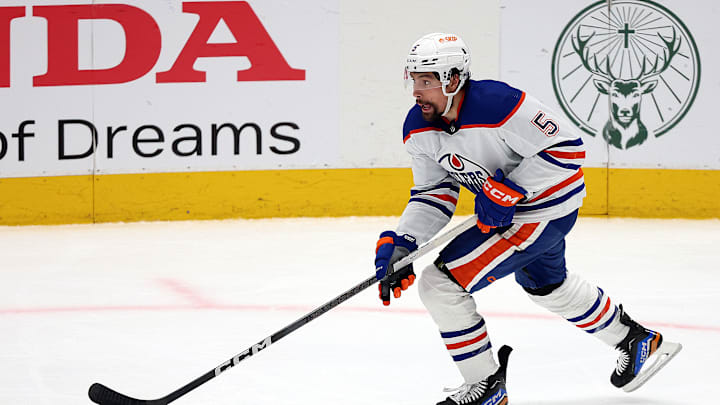It's no secret that, as per PuckPedia, the Edmonton Oilers are over the cap right now. With the Ryan Mcleod trade the Oilers moved the one expendable forward they had, to bring them down from almost $2.5 million over the cap to now. However, they'll need to make one more move to get over the hump, and there's a few different ways they can do that. Let's go through those now:
1) Trade Cody Ceci - best play
Cody Ceci lost his roster spot to Philip Broberg in the Stanley Cup final. Broberg came in under high pressure circumstances and did a very admirable job, and Ceci's play stabilized against lesser competition. Ceci formed a chemistry-laden pairing with Darnell Nurse for much of his time in the copper and blue. They were the top pairing before being replaced partway through the season in that regard by Mattias Ekholm and Evan Bouchard. Then this pairing was banished to the second pairing, and while Nurse stayed in the second pairing, Ceci struggled more and was then demoted to the third pairing.
The duo of Nurse-Broberg seemed to revitalize Nurse and at the same time provided veteran cover for the somewhat still raw yet largely finished product Broberg. I suspect with the instant chemistry they developed we will see this duo enter the regular season next year as the second pairing, rather than the Oilers retaining Ceci and re-uniting the two pairing mates from years past. There are several reasons for this:
A) Putting Ceci on the third pairing creates a VERY expensive third pairing whose cap space is better spent elsewhere. From a hockey standpoint he and Brett Kulak may have formed a pretty solid bottom pairing. However, between the $3.25 million that Ceci is pulling down and the $2.75 million that Kulak is pulling down, that means going with this pairing will cost the Oilers $6 million next season, a rather steep price to pay for two bottom pairing blueliners. Logically at least one of them should go, and Ceci is the best choice to trade
B) Ceci is a right shot d-man, and these are rarer in the NHL these days since most blueliners shoot left. This means the Oilers will get more from trading Ceci than Kulak or any forward you'd think of on the roster - maybe even a second round pick if a team is desperate enough to get into a bidding war to improve their right side.
C) Ceci only has one more year on his contract. If it doesn't work out with his new team, they can easily just cut him loose without giving up any assets.
D) The Oilers just re-upped Troy Stecher on the first day of free agency for two years at barely over $1.5 million. If you read the tea leaves, that is a much better fit as a cap hit to patrol the bottom pairing than Ceci's $3.25 million. It also makes Ceci expendable, since his replacement is already on the roster. Prior to the trade last year, Stetcher was playing on the second pairing on a lousy Arizona Coyotes team and actually doing ... well, as well as you'd expect on a lousy Arizona Coyotes team. Obviously the Oilers have done their due diligence on his injury from last season and determined he's healthy enough to play next season. This is a much better use of cap space. In fact, for this pairing (Kulak-Stecher) you're only paying $3.5375 million, almost half of what you're paying for Kulak-Ceci.
E) With the emergence of Broberg (and Bouchard less recently), the re-upping of Stetcher and the signing of Josh Brown, there is nowhere for Ceci to play on the roster next season. He has officially run out of runway, so it's best we ship him off and give him a fresh start elsewhere. A rebuilding team like San Jose might be a great destination for Ceci as a team that would take a flyer on him as a top four d-man, where expectations are lower and depth is much worse - notwithstanding trading within the division and what not.
